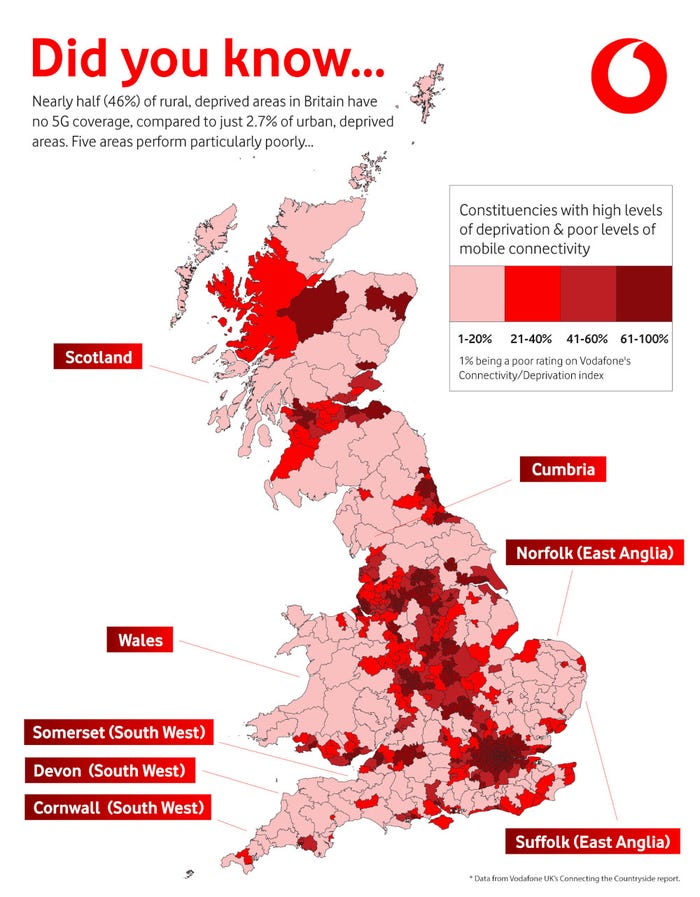Half of British rural deprived areas have no 5G – VodafoneHalf of British rural deprived areas have no 5G – Vodafone
A huge number of people living in areas of Britain classed as rural and deprived have no access to 5G networks, according to a new study published by Vodafone.
November 8, 2023

A huge number of people living in areas of Britain classed as rural and deprived have no access to 5G networks, according to a new study published by Vodafone.
With urban areas faring much better in terms of mobile coverage, the mobile operator highlights a growing digital divide, something it pledges to tackle… provided it gets the green light to merge with rival Three, of course.
Indeed, while interesting, Vodafone’s data is not remotely surprising, as anyone living in a more rural part of the country will attest. Thus, it’s hard to see this latest study as anything other than a thinly-veiled bid to garner support for the controversial merger that is currently being batted about in regulatory and governmental channels.
As many as 46% of rural deprived areas of Britain are classed as 5G not spots, according to Vodafone’s ‘Connecting the Countryside’ report, which it put together on the basis of analysis carried out by WPI Economics. Conversely, Just 2.7% of urban deprived communities lack 5G connectivity.
It identifies five areas as being particularly lacking in connectivity as well as having high levels of deprivation. It’s the usual suspects: Scotland, Wales, East Anglia, Cumbria and the South West. Almost 59% of the rural, deprived constituencies in Wales are total 5G not spots, for example, Vodafone said. Meanwhile, looking at the average area of each rural constituency that is affected by 5G not spots, Cornwall fares worst at 57.3%.

According to Vodafone, the data means that 838,000 people – it rounded up to “almost a million” – living in rural deprived areas are missing out on the potential benefits of 5G. Again, it’s the same benefits we are used to hearing in relation to 5G: better access to healthcare and education, and IoT solutions in agriculture. Vodafone chose to highlight its Skyport drone programme, which can deliver medicines to rural areas in 15 minutes, as opposed to 36 hours at present.
But while the study gives Vodafone the opportunity to talk up its own initiatives in the 5G space – and there’s nothing wrong with that – its primary purpose appears to be to remind us of the absolute necessity of its proposed merger with Three when it comes to improving connectivity in the UK.
“We believe everyone should have access to connectivity and our research shows the alarming rate at which almost a million people living in deprived rural communities are being left behind,” said Andrea Dona, Chief Network Officer at Vodafone UK. “It’s clear we need to accelerate the roll-out of the UK’s 5G infrastructure, which is what we commit to do as part of our proposed merger with Three UK. We would close the rural digital divide by delivering 95% 5G Standalone geographic coverage by 2034.”
We have heard Vodafone and Three’s pledge to extend standalone 5G coverage to 95% of the population by 2030, rising to 99% by 2034, a number of times. Doubtless all these statistics will come up again and again – alongside that oft-mentioned vow to invest £11 billion in improving network coverage – as the merger deliberations play out, particularly given that the UK government aims to deliver standalone 5G coverage to all populated areas by 2030 under its Wireless Infrastructure Strategy.
That target was referenced by Simon Fell, Conservative MP for Barrow and Furness and Rural Connectivity Champion, who was drafted in by Vodafone to provide a comment on the study.
“New research published today lays bare the challenge we face to bring connectivity to our most deprived rural communities to match the rest of the country, and to ensure that millions of people are not left out from the future innovations that 5G can provide,” Fell said. “Some of these innovations are already a reality, and simply need connectivity as the final piece of the puzzle.”
While that is the case for rural communities, the puzzle for Vodafone is more complex and there are many pieces still to be fitted. But studies like this one can only help it reach its ultimate goal.
Get the latest news straight to your inbox. Register for the Telecoms.com newsletter here.
About the Author
You May Also Like










.png?width=300&auto=webp&quality=80&disable=upscale)


_1.jpg?width=300&auto=webp&quality=80&disable=upscale)